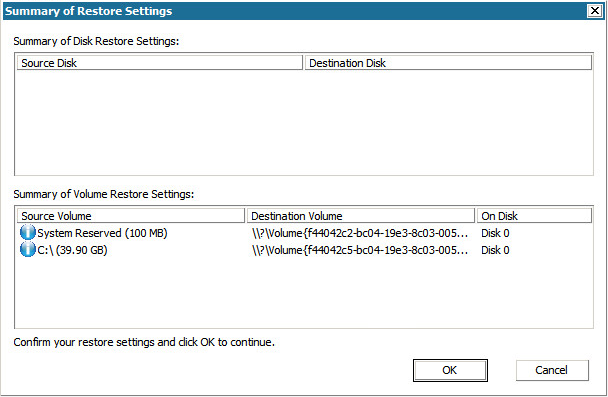Perform BMR in Express Mode
The Express Mode requires minimal interaction during the recovery process.
Follow these steps:
- From the Choose a Recovery Mode dialog, select Express Mode and click Next.
- The Summary of Disk Restore Settings screen opens, displaying a summary of the volumes that are going to be restored.
- Note: On the bottom of restore summary window, the drive letters listed in Destination Volume column are automatically generated from the Windows Preinstallation Environment (WinPE). They can be different from the drive letters listed in Source Volume column. However, the data is still restored to proper volume even if drive letters are different.
- After you have verified that the summary information is correct, click OK.
- The restore process starts. The BMR wizard screen displays the restore status for each volume.
- Depending upon the size of the volume being restored, this operation can take some time
- During this process you are restoring, block-by-block whatever you had backed up for that recovery point and creating a replica of the source machine on the target machine.
- By default, the option to reboot your system automatically after recovery is selected. If necessary, you can clear this option and you can reboot manually at a later time.
- If necessary, you can select Do not start Agent service automatically after reboot.
- If necessary, you can cancel or abort the operation at any time.
- From the Utilities menu, you can access the BMR Activity Log and you can use the Save option to save the Activity Log.
- By default, the Activity Log is saved to the following location:
- X:\windows\system32\dr\log.
- Note: To avoid getting a Windows-generated error, do not save the Activity Log on your desktop or create a folder on your desktop using the Save As option from the BMR Activity Log window.
- If you are restoring to dissimilar hardware (the SCSI/FC adapter which used to connect hard drives could have been changed) and no compatible driver is detected in your original system, a "driver injection" page is displayed to allow you to provide drivers for these devices.
- You can browse and select drivers to inject to the recovered system so that even if you are recovering to a machine with dissimilar hardware, you can still bring back the machine after BMR.
- When the BMR process is completed, a confirmation notification is displayed.

Important: If you are performing an authoritative restore of an active directory after a BMR, you must uncheck the option Automatically reboot your system after recovery and for more information, see How to Perform an Authoritative Restore of an Active Directory after a BMR.
